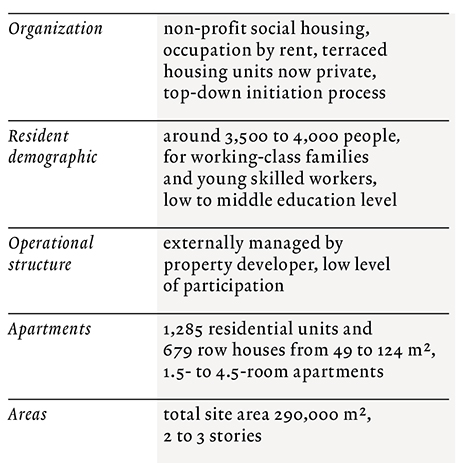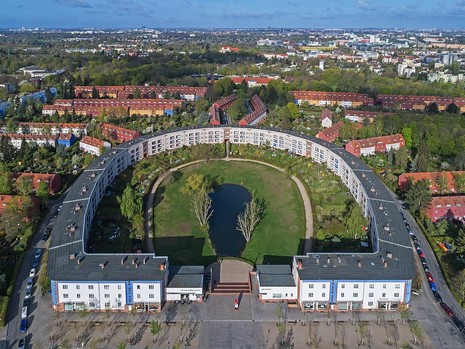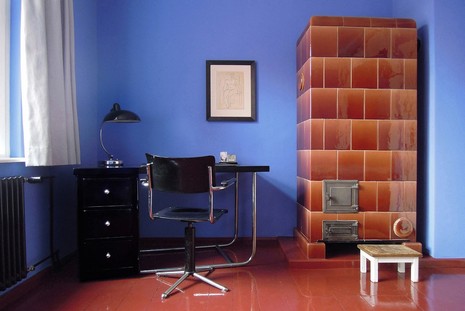Description
Constructed in several stages between 1925 and 1930 and providing housing for 3,500–4,000 people, the Hufeisen Settlement in Berlin, officially named the Britz Large Housing Estate, was a symbolic representation of the collective and cooperative spirit prevailing at that time. Architects Bruno Taut and Martin Wagner, who was later a Berlin City Councilor, designed the Hufeisen Settlement to embody the spirit of togetherness and solidarity. The public spaces of the large housing estate, such as the courtyard and plaza, were of great importance, intended to create community by acting as outdoor living spaces.[1] The Hufeisen Settlement was nothing if not cooperative architecture, socio-politically identifying with the working-class population,[2] with even the property developer, Gemeinnützige Heimstätten AG (Non-profit Homes AG) founded by German trade unions.[3] This vision was accompanied by Bruno Taut’s conception of home as a creation of the woman, promising to relieve her burdens by increasing the efficiency of housework.[4]
In addition to 679 terraced houses with private kitchen gardens, a total of 1,285 residential units were constructed in the Hufeisen Settlement and additional multi- story apartment buildings. All residential units had one-and-a-half to four-and-a-half rooms and followed four basic typologies that were technically and organizationally rationalized in the spirit of Modernism and functioned fully autonomously, without shared spaces.[5] The collective aspect was in the additional infrastructure facilities such as schools, kindergartens, and a café in the so-called outdoor living space of the horseshoe-shaped building’s courtyard. This space could be entered from the street via a large staircase or through the basement floor. Fruit trees lined the periphery, and a pond stood at the center. In the beginning, this outdoor living space was used only occasionally, since working-class families were unaccustomed to having access to usable green space and likely had inhibitions about using the symbolically important courtyard.[6] Only through organized activities did residents begin using the outdoor living space as intended.
 Selected project data
Selected project data
 Aerial view of the estate
Aerial view of the estate
 Interior of restored dwelling
Interior of restored dwelling
Footnotes
Nerdinger, Winfried, Eisen, Markus, Strobl, Hilde (2012): Manifeste zur Veränderung der Gesellschaft, p. 252.
Technische Universität Berlin (ed.) (1980): Hufeisensiedlung Britz 1926– 1980, Ein alternativer Siedlungsbau der 20er Jahre als Studienobjekt, p. 24 f.
Nerdinger, Winfried, Eisen, Markus, Strobl, Hilde (2012): Manifeste zur Veränderung der Gesellschaft, p. 253.
According to Bruno Taut’s essay “The New Dwelling, the Woman as Creator”, for women the housing settlement was simultaneously worksite and home. Technische Universität Berlin (ed.) (1980): Hufeisensiedlung Britz 1926–1980, Ein alternativer Siedlungsbau der 20er Jahre als Studienobjekt, p. 27.
Nerdinger, Winfried, Eisen, Markus, Strobl, Hilde (2012): Manifeste zur Veränderung der Gesellschaft, p. 259.
Technische Universität Berlin (ed.) (1980): Hufeisensiedlung Britz 1926– 1980, Ein alternativer Siedlungsbau der 20er Jahre als Studienobjekt, p. 79.
Originally published in: Susanne Schmid, Dietmar Eberle, Margrit Hugentobler (eds.), A History of Collective Living. Forms of Shared Housing, Birkhäuser, 2019. Translation by Word Up!, LLC, edited for Building Types Online.